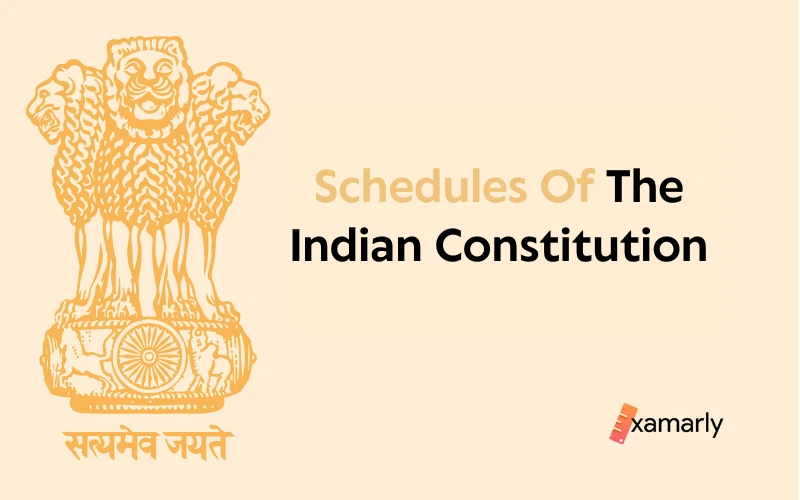In essence, schedules are tables that include extra information not covered in the articles.
There were eight schedules in the original Indian Constitution.
Different revisions resulted in the addition of four more schedules, bringing the total to twelve.
The text provides an insightful overview of all 12 Schedules of the Indian Constitution. The Schedules of the Indian Constitution are part of the UPSC Indian Polity and Governance Syllabus.
For competitive exam preparation like UPSC, this article is worth reading as it gives you a knowledgeable insight over the provisions of these schedules as well as provides unique tricks and shortcuts to memorize it in no time.
- Schedules And Amendments Of The Indian Constitution
- Objectives Of Schedules
- Attributes of Schedules
- List Of Schedules Of The Indian Constitution
- Tricks To Remember Schedules Of The Indian Constitution
- Conclusion
- UPSC PYQs On Schedules Of Indian Constitution
- FAQs
- Indian Constitution Consists Of How Many Articles And Schedules?
- How Many Languages Are In The 8th Schedule Of The Indian Constitution?
- Which States Are Included In Schedule 6 Of The Indian Constitution As Tribal Areas?
- How Will Anyone Be Able To Recall The 12 Schedules Of The Indian Constitution?
- Which Schedule Of Indian Constitution Speaks About The Forms Of Oath?
- Which Amendment Has Added 4 More Schedules To The Indian Constitution?
Schedules And Amendments Of The Indian Constitution
In the Indian Constitution, there are lists called schedules that classify and summarise administrative practices and governmental policies.
As of right now, the Indian Constitution has 12 Schedules.
The Government of India Act, of 1935, which comprised 10 Schedules, provided one of the earliest references to Schedules.
There were initially eight schedules in the Indian Constitution.
- The First Amendment Act added the ninth schedule,
- The 35th Amendment [Sikkim as Associate State] added the tenth schedule first.
- The 10 Schedule was revoked once Sikkim was admitted as a state of India, but it was later reinstated by the fifty-second amendment act of 1985 in connection with the Anti-defection law.
- Thanks to the seventy-third amendment and seventy-fourth amendment of the Constitution for adding the 11th and 12th Schedule.
Objectives Of Schedules
By separating the legal part from the supplemental information, schedules of the Indian Constitution are employed to simplify and make the provisions of the act easier to grasp.
Despite the fact that these schedules make up a significant portion of the Constitution, they are not contained there and are instead included as independent papers.
- Since the constitution of India is the longest and certain additional information needed to be provided with the articles but would make the constitution more difficult to comprehend, the notion of the Indian Constitution Schedule List was added.
- Schedules were subsequently added to allow for the addition of any additional information pertaining to an article or part that was not included in the constitution’s articles.
- Instead of keeping the information separate, if there was no such division, the article would need to be revised whenever new information or changes were made. The schedule is used by several other legislation for various reasons in addition to the Indian Constitution.
- It also sets a list of the subjects that fall under the control of the Union, the State, or both, in addition to the list of states and union territories.
- This makes it valuable for a range of objectives depending on the requirements of the legislation.
- Schedules can also be utilized when a certain portion or piece of legislation calls for more details or explanation.
Attributes of Schedules
The reader can more easily understand and analyze Indian law thanks to schedules in the Indian Constitution.
- It does not include legal information but rather understandable technical and administrative information.
- The length and size of all the texts that make up the schedule of the Indian Constitution’s extra information are appropriate.
- Schedules facilitate modifying the articles, adding or deleting provisions, and making modifications considerably easier due to their discrete parts.
- The schedules are listed in order of the provisions’ chronological appearance.
- The schedules make it easy to incorporate supplementary information within the articles, which is the main text. For instance, the 2nd schedule and article 125 both define the wage of Supreme Court judges.
- Graphs, flowcharts, and numbers are just a few examples of the several ways that schedules can be presented to display the information and ensure that it is as simple as possible.
List Of Schedules Of The Indian Constitution
The Indian Constitution has 12 schedules in total. To comprehend the 12 schedules of the Indian Constitution and the clauses contained in them, refer to the table below.
| SCHEDULE | WHAT IT CONTAINS | CONCERNED ARTICLES |
| First Schedule | 1. It covers the names of states as well as union territories. 2. Additionally, states’ territorial jurisdiction is covered. | Article 1 and Article 4 |
| Second Schedule | The provisions concerning allowances, emoluments, and privileges of: 1. President of India 2. Judges of the High Court and Supreme Court 3. Speaker as well as Deputy Speaker of Legislative Assemblies of States of India 4. Governors of States of India 5. Chairman and Deputy Chairman of the Upper House of Parliament 6. Speaker as well as Deputy Speaker of Lok Sabha 7. Chairman as well as Deputy Chairman of the Legislative Councils of the States of India 8. Comptroller and Auditor General of India | a) Article 59 b) Article 65 c) Article 75 d) Article 97 e) Article 125 f) Article 148 g) Article 158 h) Article 164 i) Article 186 j) Article 221 |
| Third Schedule | Every constitutional post requires an oath and affirmation. | a) Article 75 b) Article 84 c) Article 99 d) Article 124 e) Article 146 f) Article 173 g) Article 188 h) Article 219 |
| Fourth Schedule | It outlines provisions on how seats in the Rajya Sabha would be allocated to States and Union Territories. | Article 4 and Article 80 |
| Fifth Schedule | The management and regulation of scheduled areas as well as scheduled tribes are addressed in its provisions. | Article 244 |
| Sixth Schedule | It includes provisions for the administration of tribal areas in the states of: a) Tripura b) Assam c) Meghalaya d) Mizoram | Article 244 and Article 275 |
| Seventh Schedule | The following three legislative lists are addressed in this schedule: a) Concurrent List b) States List c) Union List | Article 246 |
| Eighth Schedule | The 22 official languages of India that are recognized under the Constitution are covered by it. | Article 344 and Article 351 |
| Ninth Schedule | It discusses state laws and ordinances that address land reforms and the eradication of the zamindari system. It also discusses the legislation and rules passed by the Parliament that address several other subjects. Note: The Ninth Schedule was added by the First Amendment Act of 1951 to shield the laws contained therein from judicial review on the ground of violation of basic rights. However, the Supreme Court determined in 2007 that from April 24, 1973, the statutes listed in this schedule are now subject to judicial scrutiny. | Article 31-B |
| Tenth Schedule | On the ground of defection, it specifies regulations relating to the disqualification of members of the State Legislatures and Parliament. | Article 102 and Article 191 |
| Eleventh Schedule | It features provisions that outline Panchayats’ rights, obligations, and scope of authority. 29 matters are included. | Article 243-G |
| Twelfth Schedule | It focuses on the provisions that outline the duties, rights, and obligations of municipalities. There are 18 matters. | Article 243-W |
Tricks To Remember Schedules Of The Indian Constitution
Even though the pathway of passing a competitive exam like the civil service examination is challenging, with rigorous preparation, you can pass the IAS exam and start working as a civil servant right away.
To help you memorize the 12 schedules of the Constitution, utilize the shortcut to remember schedules of the Indian constitution provided below:
Terrifying Eskimos Applauded Roughly So Owls Fled Offensively Likewise Ditzy Pinocchio Mused.
T – Territories
E – Emoluments
A – Affirmations
R – Rajya Sabha
S – Scheduled Areas
O – Other Areas
F – Federal Structure
O – Official languages
L – land Reforms
D – Defection laws
P – Panchayat
M – Municipality
Conclusion
The Indian Constitution is clarified through the use of schedules. They are utilized by numerous laws.
There are twelve schedules in total. It contains additional details that were not included in the constitution’s articles.
UPSC PYQs On Schedules Of Indian Constitution
1. The Ninth Schedule was introduced in the Constitution of India during the prime
ministership of (2019)
(a) Jawahar Lal Nehru
(b) Lal Bahadur Shastri
(c) Indira Gandhi
(d) Morarji Desai
Ans (a) Jawahar Lal Nehru
Explanation: The Nehru government tabled it on May 10th, 1951, to address judicial rulings and announcements, particularly those pertaining to the fundamental rights chapter.
2. Under which schedule of the constitution of India can the transfer of tribal land to private parties for mining be declared null and void? (2019)
(a) Third Schedule
(b) Fifth Schedule
(c) Ninth Schedule
(d) Twelfth Schedule
Ans (b) Fifth Schedule
Explanation: The Governor of a state has the authority to enact regulations that forbid or limit the transfer of land by Schedule Tribes under the Constitution’s Fifth Schedule.
The Governor may also limit the application of a specific Act of Parliament or state legislature to a scheduled area or any section of it.
The right to transfer tribal territory to private companies for mining is so defined by the Constitution in order to protect cultural autonomy and provide the tribal population with more authority.
3. Which one of the following Schedules of the Constitution of India contains provisions regarding anti-defection? (2014)
(a) 2nd Schedule
(b) 5th Schedule
(c) 8th Schedule
(d) 10th Schedule
Ans (d) 10th Schedule
4. Which schedule of the Constitution of India contains special provisions for the
administration and control of scheduled areas in some states? (2008)
(a) Third
(b) Fifth
(c) Seventh
(d) Ninth
Ans (b) 5th Schedule
5 Consider the following statements
1. The Constitution of India has 22 parts.
2. There are 395 Articles in the Constitution of India.
3. Ninth, Tenth, Eleventh, and Twelfth Schedules were added to the constitution of India by the Constitution (Amendment) Acts
Which of the statements given above is/are correct? (2005)
(a) 1 and 2
(b) 2 Only
(c) 3 Only
(d) 1, 2, and 3
Ans (c) 3 only
Explanation: Currently, the Indian Constitution consists of 25 parts, 12 schedules, and 448 articles.
There were 22 parts, 8 schedules, and 395 articles in the original constitution.
The First Constitutional Amendment Act of 1951 added the ninth schedule.
The 52nd Constitutional Amendment Act of 1985 added the Tenth Schedule.
By the 73rd Constitutional Amendment Act of 1992, the eleventh schedule was inserted.
The 74th Constitutional Amendment Act of 1992 added the Twelfth Schedule.
FAQs
Indian Constitution Consists Of How Many Articles And Schedules?
448 articles and 12 Schedules are part of the Indian Constitution at present. However, 395 articles in 22 parts and 8 schedules made up the Constitution’s original text. On January 26, 1950, the day that India commemorates Republic Day each year, it went into effect.
How Many Languages Are In The 8th Schedule Of The Indian Constitution?
22 Indian languages are officially recognized under the 8th Schedule of the Indian Constitution?
Which States Are Included In Schedule 6 Of The Indian Constitution As Tribal Areas?
The sixth schedule speaks about the administration of the tribal areas in Assam, Tripura, Meghalaya, and Mizoram. One can remember the name of these states with the word “ATMM”. Here A stands for Assam, T stands for Tripura, and both M Stands for Meghalaya and Mizoram.
How Will Anyone Be Able To Recall The 12 Schedules Of The Indian Constitution?
By using mnemonics, mindmaps, visualizations, or flowcharts, anyone may quickly recall and retain all 12 schedules in their memory. Even you can make up a tale based on the important keywords in these schedules. The keywords actually allude to a constitutional provision from that particular schedule, aiding in your memory of its precise contents. For example, “money” is the keyword that is suitable for the 2nd schedule. As 2nd schedule is all about emoluments, privileges, and salary.
Also, you can use the mnemonic provided here in the article to learn all these 12 schedules in chronological order with ease.
Which Schedule Of Indian Constitution Speaks About The Forms Of Oath?
The different oaths required for those holding various constitutional offices are included in the third schedule.
Which Amendment Has Added 4 More Schedules To The Indian Constitution?
The first amendment, fifty-second Amendment, seventy-third Amendment, and seventy-fourth amendment have added the 4 schedules to the Indian Constitution.
The ninth schedule was inserted by the 1st amendment of the Indian Constitution, while the tenth schedule was first added by the 35th Amendment (with Sikkim as an Associate State).
The 10 Schedule was removed once Sikkim was recognized as a state of India, but it was later restored in connection with the Anti-defection statute by the fifty-second amendment act of 1985. The 11th and 12th Schedules were added to the Constitution by the 73rd and 74th Amendments, respectively.






